The Economics of Sustainable Development: A Comprehensive Report
VerifiedAdded on 2020/11/12
|10
|3705
|252
Report
AI Summary
This report delves into the economics of sustainable development, critically evaluating the neo-classical theory of economic growth. It explores the core tenets of this theory, including its emphasis on factors like technology, capital, and labor, and assesses its advantages and disadvantages in understanding economic growth rates. The report also examines the role of foreign aid in developing countries, analyzing its various types, purposes, and potential impacts on economic growth, including GDP increases and the fostering of political ties. It discusses both the positive and negative effects of foreign aid, considering factors such as the recipient's needs, potential for misuse, and the influence of international organizations. The report uses various sources to support the arguments and provide a comprehensive analysis of the complex relationship between economic theories, foreign aid, and sustainable development in developing countries. Additionally, the report addresses the United Nations’ Sustainable Development goals and their impact on economic growth of a developing country, although the analysis is not included in the provided text.
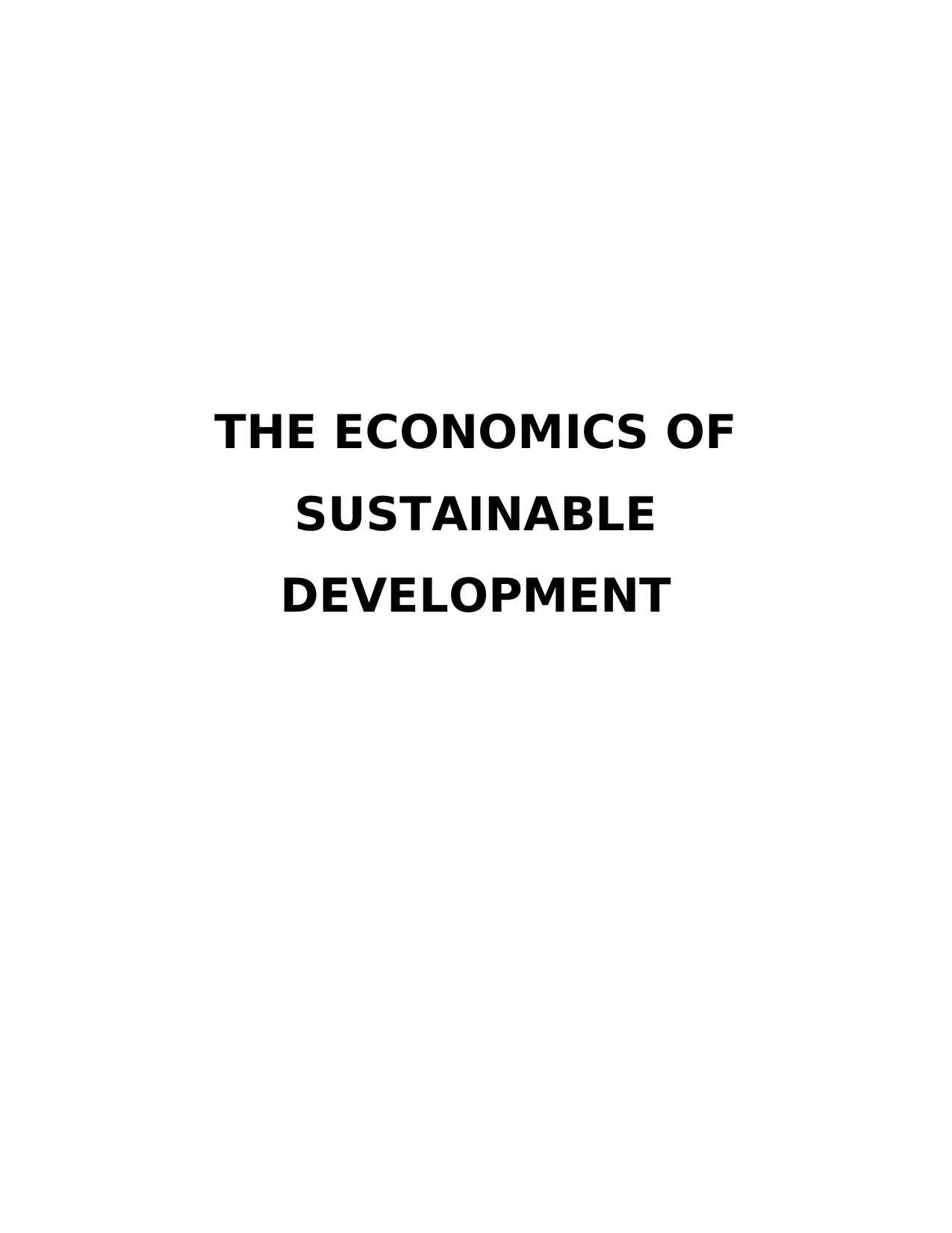
THE ECONOMICS OF
SUSTAINABLE
DEVELOPMENT
SUSTAINABLE
DEVELOPMENT
Paraphrase This Document
Need a fresh take? Get an instant paraphrase of this document with our AI Paraphraser
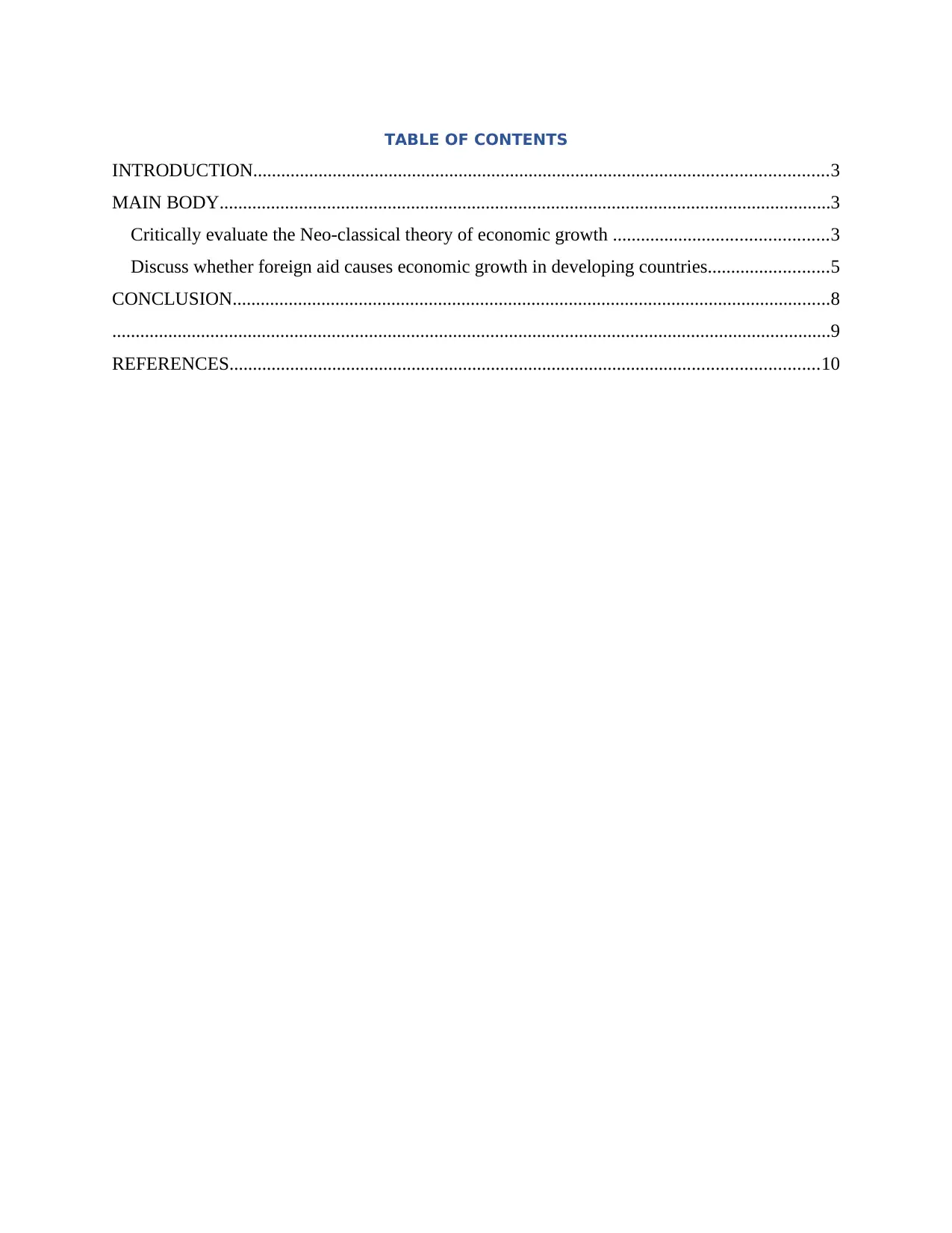
TABLE OF CONTENTS
INTRODUCTION...........................................................................................................................3
MAIN BODY...................................................................................................................................3
Critically evaluate the Neo-classical theory of economic growth ..............................................3
Discuss whether foreign aid causes economic growth in developing countries..........................5
CONCLUSION................................................................................................................................8
..........................................................................................................................................................9
REFERENCES..............................................................................................................................10
INTRODUCTION...........................................................................................................................3
MAIN BODY...................................................................................................................................3
Critically evaluate the Neo-classical theory of economic growth ..............................................3
Discuss whether foreign aid causes economic growth in developing countries..........................5
CONCLUSION................................................................................................................................8
..........................................................................................................................................................9
REFERENCES..............................................................................................................................10
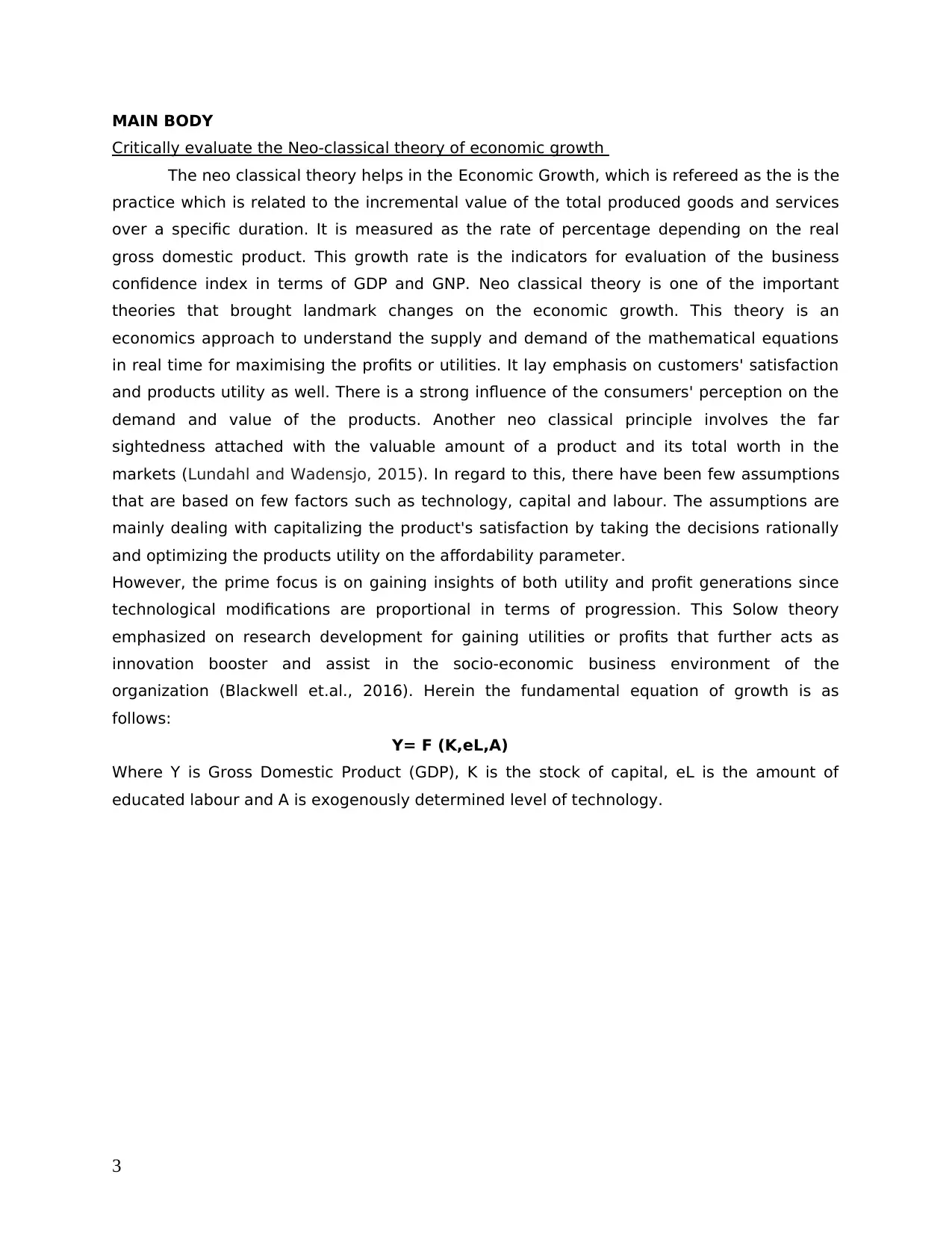
MAIN BODY
Critically evaluate the Neo-classical theory of economic growth
The neo classical theory helps in the Economic Growth, which is refereed as the is the
practice which is related to the incremental value of the total produced goods and services
over a specific duration. It is measured as the rate of percentage depending on the real
gross domestic product. This growth rate is the indicators for evaluation of the business
confidence index in terms of GDP and GNP. Neo classical theory is one of the important
theories that brought landmark changes on the economic growth. This theory is an
economics approach to understand the supply and demand of the mathematical equations
in real time for maximising the profits or utilities. It lay emphasis on customers' satisfaction
and products utility as well. There is a strong influence of the consumers' perception on the
demand and value of the products. Another neo classical principle involves the far
sightedness attached with the valuable amount of a product and its total worth in the
markets (Lundahl and Wadensjo, 2015). In regard to this, there have been few assumptions
that are based on few factors such as technology, capital and labour. The assumptions are
mainly dealing with capitalizing the product's satisfaction by taking the decisions rationally
and optimizing the products utility on the affordability parameter.
However, the prime focus is on gaining insights of both utility and profit generations since
technological modifications are proportional in terms of progression. This Solow theory
emphasized on research development for gaining utilities or profits that further acts as
innovation booster and assist in the socio-economic business environment of the
organization (Blackwell et.al., 2016). Herein the fundamental equation of growth is as
follows:
Y= F (K,eL,A)
Where Y is Gross Domestic Product (GDP), K is the stock of capital, eL is the amount of
educated labour and A is exogenously determined level of technology.
3
Critically evaluate the Neo-classical theory of economic growth
The neo classical theory helps in the Economic Growth, which is refereed as the is the
practice which is related to the incremental value of the total produced goods and services
over a specific duration. It is measured as the rate of percentage depending on the real
gross domestic product. This growth rate is the indicators for evaluation of the business
confidence index in terms of GDP and GNP. Neo classical theory is one of the important
theories that brought landmark changes on the economic growth. This theory is an
economics approach to understand the supply and demand of the mathematical equations
in real time for maximising the profits or utilities. It lay emphasis on customers' satisfaction
and products utility as well. There is a strong influence of the consumers' perception on the
demand and value of the products. Another neo classical principle involves the far
sightedness attached with the valuable amount of a product and its total worth in the
markets (Lundahl and Wadensjo, 2015). In regard to this, there have been few assumptions
that are based on few factors such as technology, capital and labour. The assumptions are
mainly dealing with capitalizing the product's satisfaction by taking the decisions rationally
and optimizing the products utility on the affordability parameter.
However, the prime focus is on gaining insights of both utility and profit generations since
technological modifications are proportional in terms of progression. This Solow theory
emphasized on research development for gaining utilities or profits that further acts as
innovation booster and assist in the socio-economic business environment of the
organization (Blackwell et.al., 2016). Herein the fundamental equation of growth is as
follows:
Y= F (K,eL,A)
Where Y is Gross Domestic Product (GDP), K is the stock of capital, eL is the amount of
educated labour and A is exogenously determined level of technology.
3
⊘ This is a preview!⊘
Do you want full access?
Subscribe today to unlock all pages.

Trusted by 1+ million students worldwide
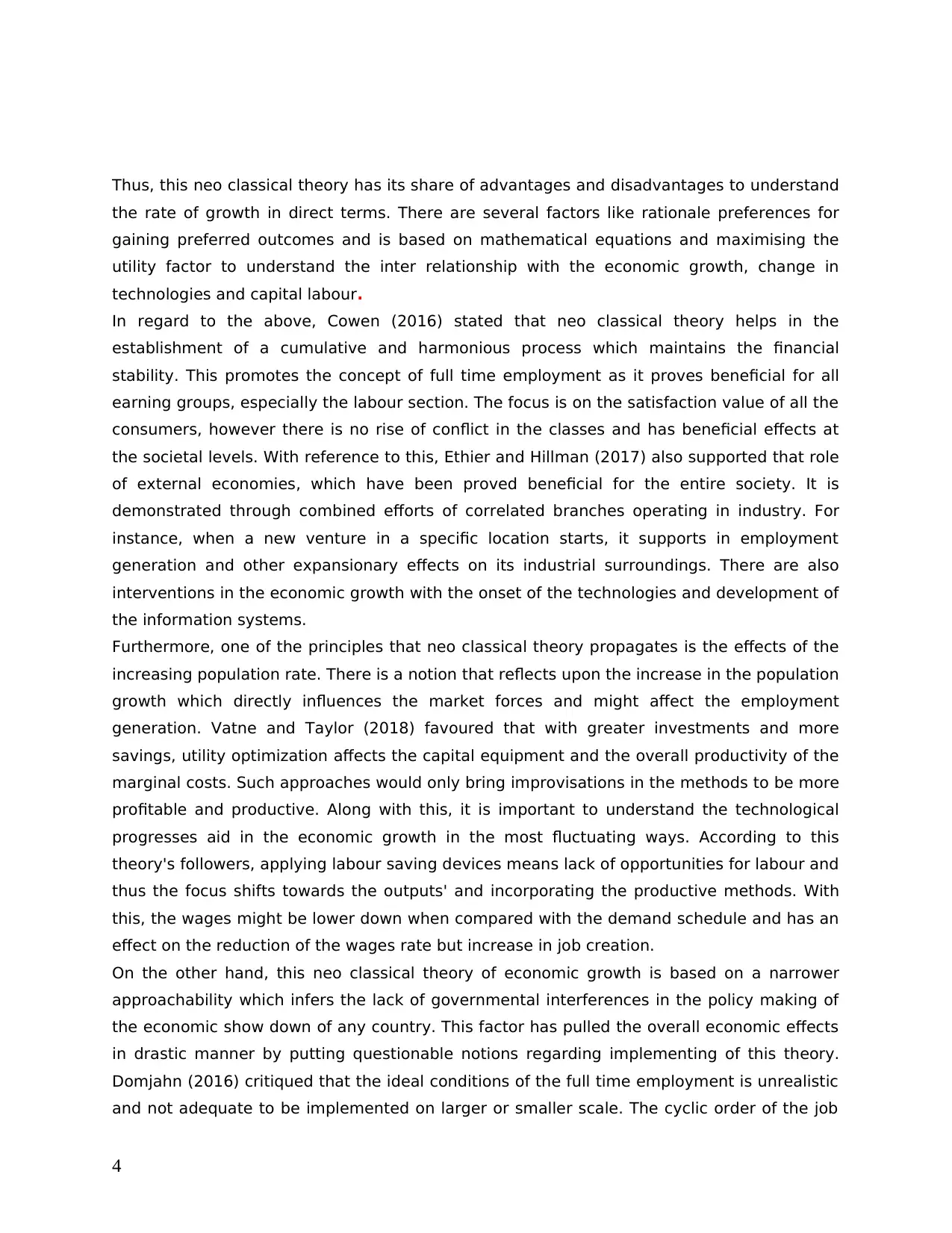
Thus, this neo classical theory has its share of advantages and disadvantages to understand
the rate of growth in direct terms. There are several factors like rationale preferences for
gaining preferred outcomes and is based on mathematical equations and maximising the
utility factor to understand the inter relationship with the economic growth, change in
technologies and capital labour.
In regard to the above, Cowen (2016) stated that neo classical theory helps in the
establishment of a cumulative and harmonious process which maintains the financial
stability. This promotes the concept of full time employment as it proves beneficial for all
earning groups, especially the labour section. The focus is on the satisfaction value of all the
consumers, however there is no rise of conflict in the classes and has beneficial effects at
the societal levels. With reference to this, Ethier and Hillman (2017) also supported that role
of external economies, which have been proved beneficial for the entire society. It is
demonstrated through combined efforts of correlated branches operating in industry. For
instance, when a new venture in a specific location starts, it supports in employment
generation and other expansionary effects on its industrial surroundings. There are also
interventions in the economic growth with the onset of the technologies and development of
the information systems.
Furthermore, one of the principles that neo classical theory propagates is the effects of the
increasing population rate. There is a notion that reflects upon the increase in the population
growth which directly influences the market forces and might affect the employment
generation. Vatne and Taylor (2018) favoured that with greater investments and more
savings, utility optimization affects the capital equipment and the overall productivity of the
marginal costs. Such approaches would only bring improvisations in the methods to be more
profitable and productive. Along with this, it is important to understand the technological
progresses aid in the economic growth in the most fluctuating ways. According to this
theory's followers, applying labour saving devices means lack of opportunities for labour and
thus the focus shifts towards the outputs' and incorporating the productive methods. With
this, the wages might be lower down when compared with the demand schedule and has an
effect on the reduction of the wages rate but increase in job creation.
On the other hand, this neo classical theory of economic growth is based on a narrower
approachability which infers the lack of governmental interferences in the policy making of
the economic show down of any country. This factor has pulled the overall economic effects
in drastic manner by putting questionable notions regarding implementing of this theory.
Domjahn (2016) critiqued that the ideal conditions of the full time employment is unrealistic
and not adequate to be implemented on larger or smaller scale. The cyclic order of the job
4
the rate of growth in direct terms. There are several factors like rationale preferences for
gaining preferred outcomes and is based on mathematical equations and maximising the
utility factor to understand the inter relationship with the economic growth, change in
technologies and capital labour.
In regard to the above, Cowen (2016) stated that neo classical theory helps in the
establishment of a cumulative and harmonious process which maintains the financial
stability. This promotes the concept of full time employment as it proves beneficial for all
earning groups, especially the labour section. The focus is on the satisfaction value of all the
consumers, however there is no rise of conflict in the classes and has beneficial effects at
the societal levels. With reference to this, Ethier and Hillman (2017) also supported that role
of external economies, which have been proved beneficial for the entire society. It is
demonstrated through combined efforts of correlated branches operating in industry. For
instance, when a new venture in a specific location starts, it supports in employment
generation and other expansionary effects on its industrial surroundings. There are also
interventions in the economic growth with the onset of the technologies and development of
the information systems.
Furthermore, one of the principles that neo classical theory propagates is the effects of the
increasing population rate. There is a notion that reflects upon the increase in the population
growth which directly influences the market forces and might affect the employment
generation. Vatne and Taylor (2018) favoured that with greater investments and more
savings, utility optimization affects the capital equipment and the overall productivity of the
marginal costs. Such approaches would only bring improvisations in the methods to be more
profitable and productive. Along with this, it is important to understand the technological
progresses aid in the economic growth in the most fluctuating ways. According to this
theory's followers, applying labour saving devices means lack of opportunities for labour and
thus the focus shifts towards the outputs' and incorporating the productive methods. With
this, the wages might be lower down when compared with the demand schedule and has an
effect on the reduction of the wages rate but increase in job creation.
On the other hand, this neo classical theory of economic growth is based on a narrower
approachability which infers the lack of governmental interferences in the policy making of
the economic show down of any country. This factor has pulled the overall economic effects
in drastic manner by putting questionable notions regarding implementing of this theory.
Domjahn (2016) critiqued that the ideal conditions of the full time employment is unrealistic
and not adequate to be implemented on larger or smaller scale. The cyclic order of the job
4
Paraphrase This Document
Need a fresh take? Get an instant paraphrase of this document with our AI Paraphraser

creation depends on several components like seasonality, demand and supply of a product
etc. This ideal concept is unreachable because it could not help in analysing the overall
impact and ensure the over exploitation of the capital or available resources. Thus, it would
not be of good assistance.
Consequently, Wisniewski (2018) highlighted the continuous and harmonious process
attached with the neo classical principles to conduct the tasks for gaining attention of the
customers'. Whereas, it is a known fact that any economic development is proportional to
the output investment, depreciation, convergence etc. and are mostly moulded on the initial
developmental stages. This discontinuity is caused due to the prevalent political scenarios
that impact the economic stability and create barriers for the free flow of knowledge
between the private and public sectors working in the same industry. Along with this, factors
like technological use in accordance to the validity of resources, population size and the
capital stock. These also act as challenging obstacles to identify the financial nature and the
overall assessment of the running of the operational activities to minimise the significance
of both factors such as economic and non-economic as well.
Moreover, Lankauskienė (2015) mentioned that there is a need to understand the concept of
diminishing returns which has also been criticised severely by economists. This component
has left many unanswered queries which mean that there is an increase in the process of
decreasing values. It means that one input is fixed and the other is at an incremental rate
which defines a constant return to scaling and conducting tasks. On the other hand, Bradley
(2019) shed light on the implementation of using constant capital and the labour is
increased. This is major requirement for the autonomous development of the knowledge and
use of technologies. Although it is important to understand that this is possible after
applying assumptions in two ways. Firstly, labour is constant and the second condition is
when the labour is held constant. These two conditions played crucial role in signifying the
international trade to bring attention to the national income. By applying the neo classical
principles, the allocation of the resources and labour division plays crucial role in attaining
maximum outputs.
According to Barca (2017) for countering such economic growth, economists adopted the
three approaches such as the new political economy approach, the free market approach
and the market oriented approach. These approached helped in mitigating the over
dependency of the international organizations and developed countries. There was an
accelerated value in the overall economic growth and development of the developing
countries with the help and support from the developed nations and institutions as well.
However, Earle et.al. (2016) suggested in opposite direction that lack of legislative
framework is seen while adopting any charities or donations and grants. However, this
5
etc. This ideal concept is unreachable because it could not help in analysing the overall
impact and ensure the over exploitation of the capital or available resources. Thus, it would
not be of good assistance.
Consequently, Wisniewski (2018) highlighted the continuous and harmonious process
attached with the neo classical principles to conduct the tasks for gaining attention of the
customers'. Whereas, it is a known fact that any economic development is proportional to
the output investment, depreciation, convergence etc. and are mostly moulded on the initial
developmental stages. This discontinuity is caused due to the prevalent political scenarios
that impact the economic stability and create barriers for the free flow of knowledge
between the private and public sectors working in the same industry. Along with this, factors
like technological use in accordance to the validity of resources, population size and the
capital stock. These also act as challenging obstacles to identify the financial nature and the
overall assessment of the running of the operational activities to minimise the significance
of both factors such as economic and non-economic as well.
Moreover, Lankauskienė (2015) mentioned that there is a need to understand the concept of
diminishing returns which has also been criticised severely by economists. This component
has left many unanswered queries which mean that there is an increase in the process of
decreasing values. It means that one input is fixed and the other is at an incremental rate
which defines a constant return to scaling and conducting tasks. On the other hand, Bradley
(2019) shed light on the implementation of using constant capital and the labour is
increased. This is major requirement for the autonomous development of the knowledge and
use of technologies. Although it is important to understand that this is possible after
applying assumptions in two ways. Firstly, labour is constant and the second condition is
when the labour is held constant. These two conditions played crucial role in signifying the
international trade to bring attention to the national income. By applying the neo classical
principles, the allocation of the resources and labour division plays crucial role in attaining
maximum outputs.
According to Barca (2017) for countering such economic growth, economists adopted the
three approaches such as the new political economy approach, the free market approach
and the market oriented approach. These approached helped in mitigating the over
dependency of the international organizations and developed countries. There was an
accelerated value in the overall economic growth and development of the developing
countries with the help and support from the developed nations and institutions as well.
However, Earle et.al. (2016) suggested in opposite direction that lack of legislative
framework is seen while adopting any charities or donations and grants. However, this
5

facilitates the developing countries to flourish and gain upper hand for improving their
conditions in context to socio-economic aspects.
Discuss whether foreign aid causes economic growth in developing countries
Foreign aid is defined as the transfer of goods, services and capital from international
organization or foreign country in order to benefit the needy people or recipient country at
international levels (Reitz, 2018). These are of several types such as military aid,
humanitarian aid, economic aid and others. Before discussing about its role in the growth of
the developing countries, it is imperative to understand the purpose. The focus is on
bridging the communication gaps and helping to bring a robust framework for safeguarding
the security concerns. Additionally, it is useful for developing countries or friendly countries
in prevention from the surrounding unfriendly neighbouring countries to manage the
financial aid (Arango, 2017). For instance, United States is among the few countries which
has topped the largest foreign aid to the other developing countries like Vietnam, Iran and
Indonesia etc. and has also set up an international agency named as USAID (United States
Agency for International Development).
Moreover, it is considered as an important tool to bring positive and concrete changes at the
socio-economic levels. It has been demonstrated that economic growth of the recipient
countries is in better positioning after outsourcing the foreign aid. Along with, the outcomes
are shown that around 0.031 percentage points increases the GDP (Gross Domestic Product)
growth by enhanced levels (Friedman, 2017). This aid is laid to mitigate the sufferings which
occurred due to any uncertain adversity or natural calamity. Foreign aid is beneficial in
fostering the economic development for strengthening the political ties and establishing
systematic frameworks to avoid any illegal activities or misuse of this financial assistance. In
regard to this, foreign aid has helped in increasing the economic growth to address the
queries and any immediate remedial needs of the affected population. For e,g. when Syrians
were hit badly due to the war, almost all the countries and the well-established
organizations like United Nations, World Bank and International Monetary Fund etc. offered
their help through allocation of fund at both national and international levels.
However, there are several positive effects on the developing countries like Vietnam,
Pakistan etc. where types of foreign needs sometimes have different features to be
implemented and the overall impact never differs and remains constant. Japan is among few
countries which has developed an extensive foreign aid program to gain the attention of the
developed nations towards fulfilment of the needs of the developing countries (Dabla-Norris
etal., 2015). Furthermore, it is also helping the developing countries as a part of
peacekeeping activities via military aid or humanitarian aid. This directly has enhanced the
economic growth rate at the trading levels at the global competitive markets. The
widespread economic differences between rich and poor countries were demonstrated
6
conditions in context to socio-economic aspects.
Discuss whether foreign aid causes economic growth in developing countries
Foreign aid is defined as the transfer of goods, services and capital from international
organization or foreign country in order to benefit the needy people or recipient country at
international levels (Reitz, 2018). These are of several types such as military aid,
humanitarian aid, economic aid and others. Before discussing about its role in the growth of
the developing countries, it is imperative to understand the purpose. The focus is on
bridging the communication gaps and helping to bring a robust framework for safeguarding
the security concerns. Additionally, it is useful for developing countries or friendly countries
in prevention from the surrounding unfriendly neighbouring countries to manage the
financial aid (Arango, 2017). For instance, United States is among the few countries which
has topped the largest foreign aid to the other developing countries like Vietnam, Iran and
Indonesia etc. and has also set up an international agency named as USAID (United States
Agency for International Development).
Moreover, it is considered as an important tool to bring positive and concrete changes at the
socio-economic levels. It has been demonstrated that economic growth of the recipient
countries is in better positioning after outsourcing the foreign aid. Along with, the outcomes
are shown that around 0.031 percentage points increases the GDP (Gross Domestic Product)
growth by enhanced levels (Friedman, 2017). This aid is laid to mitigate the sufferings which
occurred due to any uncertain adversity or natural calamity. Foreign aid is beneficial in
fostering the economic development for strengthening the political ties and establishing
systematic frameworks to avoid any illegal activities or misuse of this financial assistance. In
regard to this, foreign aid has helped in increasing the economic growth to address the
queries and any immediate remedial needs of the affected population. For e,g. when Syrians
were hit badly due to the war, almost all the countries and the well-established
organizations like United Nations, World Bank and International Monetary Fund etc. offered
their help through allocation of fund at both national and international levels.
However, there are several positive effects on the developing countries like Vietnam,
Pakistan etc. where types of foreign needs sometimes have different features to be
implemented and the overall impact never differs and remains constant. Japan is among few
countries which has developed an extensive foreign aid program to gain the attention of the
developed nations towards fulfilment of the needs of the developing countries (Dabla-Norris
etal., 2015). Furthermore, it is also helping the developing countries as a part of
peacekeeping activities via military aid or humanitarian aid. This directly has enhanced the
economic growth rate at the trading levels at the global competitive markets. The
widespread economic differences between rich and poor countries were demonstrated
6
⊘ This is a preview!⊘
Do you want full access?
Subscribe today to unlock all pages.

Trusted by 1+ million students worldwide
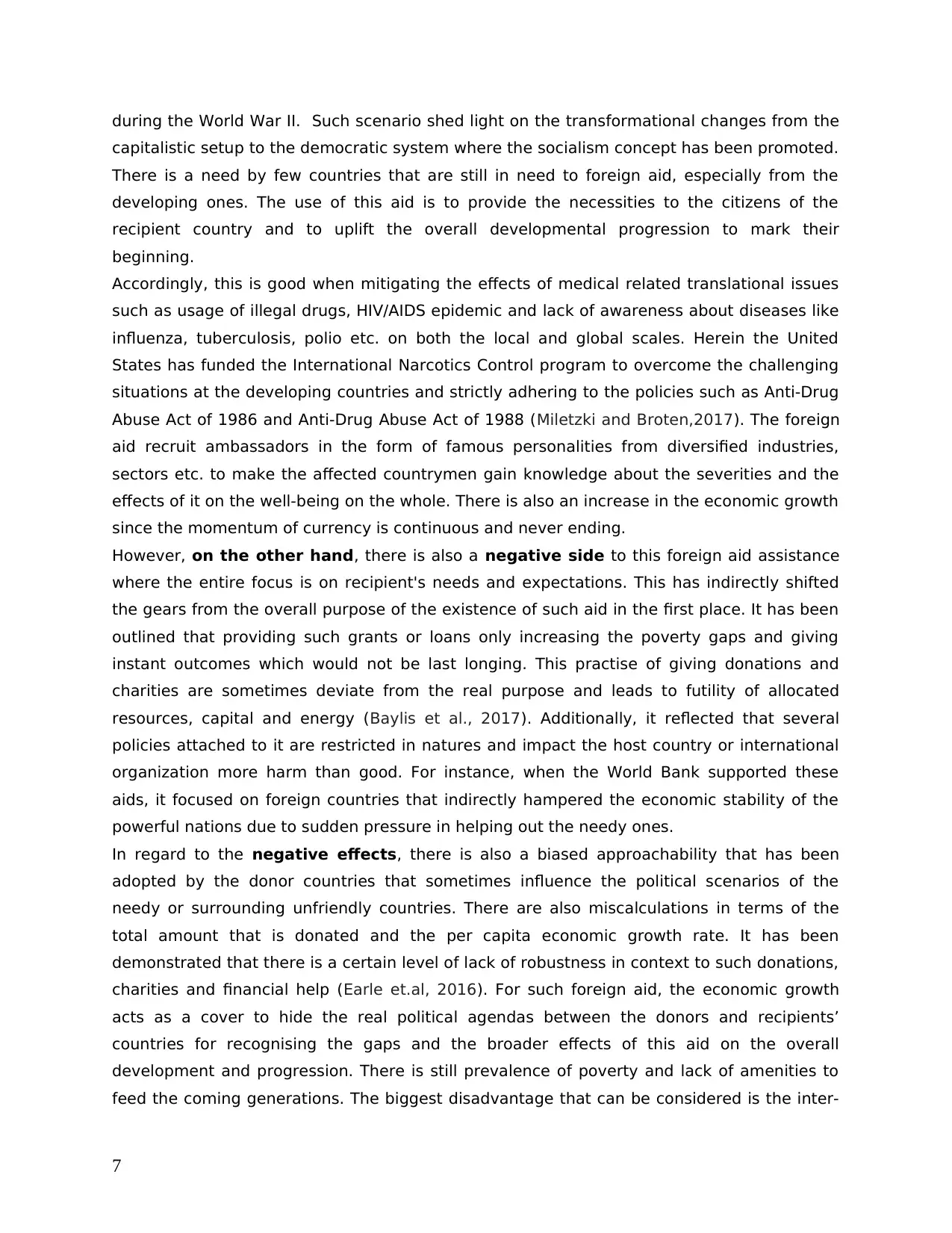
during the World War II. Such scenario shed light on the transformational changes from the
capitalistic setup to the democratic system where the socialism concept has been promoted.
There is a need by few countries that are still in need to foreign aid, especially from the
developing ones. The use of this aid is to provide the necessities to the citizens of the
recipient country and to uplift the overall developmental progression to mark their
beginning.
Accordingly, this is good when mitigating the effects of medical related translational issues
such as usage of illegal drugs, HIV/AIDS epidemic and lack of awareness about diseases like
influenza, tuberculosis, polio etc. on both the local and global scales. Herein the United
States has funded the International Narcotics Control program to overcome the challenging
situations at the developing countries and strictly adhering to the policies such as Anti-Drug
Abuse Act of 1986 and Anti-Drug Abuse Act of 1988 (Miletzki and Broten,2017). The foreign
aid recruit ambassadors in the form of famous personalities from diversified industries,
sectors etc. to make the affected countrymen gain knowledge about the severities and the
effects of it on the well-being on the whole. There is also an increase in the economic growth
since the momentum of currency is continuous and never ending.
However, on the other hand, there is also a negative side to this foreign aid assistance
where the entire focus is on recipient's needs and expectations. This has indirectly shifted
the gears from the overall purpose of the existence of such aid in the first place. It has been
outlined that providing such grants or loans only increasing the poverty gaps and giving
instant outcomes which would not be last longing. This practise of giving donations and
charities are sometimes deviate from the real purpose and leads to futility of allocated
resources, capital and energy (Baylis et al., 2017). Additionally, it reflected that several
policies attached to it are restricted in natures and impact the host country or international
organization more harm than good. For instance, when the World Bank supported these
aids, it focused on foreign countries that indirectly hampered the economic stability of the
powerful nations due to sudden pressure in helping out the needy ones.
In regard to the negative effects, there is also a biased approachability that has been
adopted by the donor countries that sometimes influence the political scenarios of the
needy or surrounding unfriendly countries. There are also miscalculations in terms of the
total amount that is donated and the per capita economic growth rate. It has been
demonstrated that there is a certain level of lack of robustness in context to such donations,
charities and financial help (Earle et.al, 2016). For such foreign aid, the economic growth
acts as a cover to hide the real political agendas between the donors and recipients’
countries for recognising the gaps and the broader effects of this aid on the overall
development and progression. There is still prevalence of poverty and lack of amenities to
feed the coming generations. The biggest disadvantage that can be considered is the inter-
7
capitalistic setup to the democratic system where the socialism concept has been promoted.
There is a need by few countries that are still in need to foreign aid, especially from the
developing ones. The use of this aid is to provide the necessities to the citizens of the
recipient country and to uplift the overall developmental progression to mark their
beginning.
Accordingly, this is good when mitigating the effects of medical related translational issues
such as usage of illegal drugs, HIV/AIDS epidemic and lack of awareness about diseases like
influenza, tuberculosis, polio etc. on both the local and global scales. Herein the United
States has funded the International Narcotics Control program to overcome the challenging
situations at the developing countries and strictly adhering to the policies such as Anti-Drug
Abuse Act of 1986 and Anti-Drug Abuse Act of 1988 (Miletzki and Broten,2017). The foreign
aid recruit ambassadors in the form of famous personalities from diversified industries,
sectors etc. to make the affected countrymen gain knowledge about the severities and the
effects of it on the well-being on the whole. There is also an increase in the economic growth
since the momentum of currency is continuous and never ending.
However, on the other hand, there is also a negative side to this foreign aid assistance
where the entire focus is on recipient's needs and expectations. This has indirectly shifted
the gears from the overall purpose of the existence of such aid in the first place. It has been
outlined that providing such grants or loans only increasing the poverty gaps and giving
instant outcomes which would not be last longing. This practise of giving donations and
charities are sometimes deviate from the real purpose and leads to futility of allocated
resources, capital and energy (Baylis et al., 2017). Additionally, it reflected that several
policies attached to it are restricted in natures and impact the host country or international
organization more harm than good. For instance, when the World Bank supported these
aids, it focused on foreign countries that indirectly hampered the economic stability of the
powerful nations due to sudden pressure in helping out the needy ones.
In regard to the negative effects, there is also a biased approachability that has been
adopted by the donor countries that sometimes influence the political scenarios of the
needy or surrounding unfriendly countries. There are also miscalculations in terms of the
total amount that is donated and the per capita economic growth rate. It has been
demonstrated that there is a certain level of lack of robustness in context to such donations,
charities and financial help (Earle et.al, 2016). For such foreign aid, the economic growth
acts as a cover to hide the real political agendas between the donors and recipients’
countries for recognising the gaps and the broader effects of this aid on the overall
development and progression. There is still prevalence of poverty and lack of amenities to
feed the coming generations. The biggest disadvantage that can be considered is the inter-
7
Paraphrase This Document
Need a fresh take? Get an instant paraphrase of this document with our AI Paraphraser
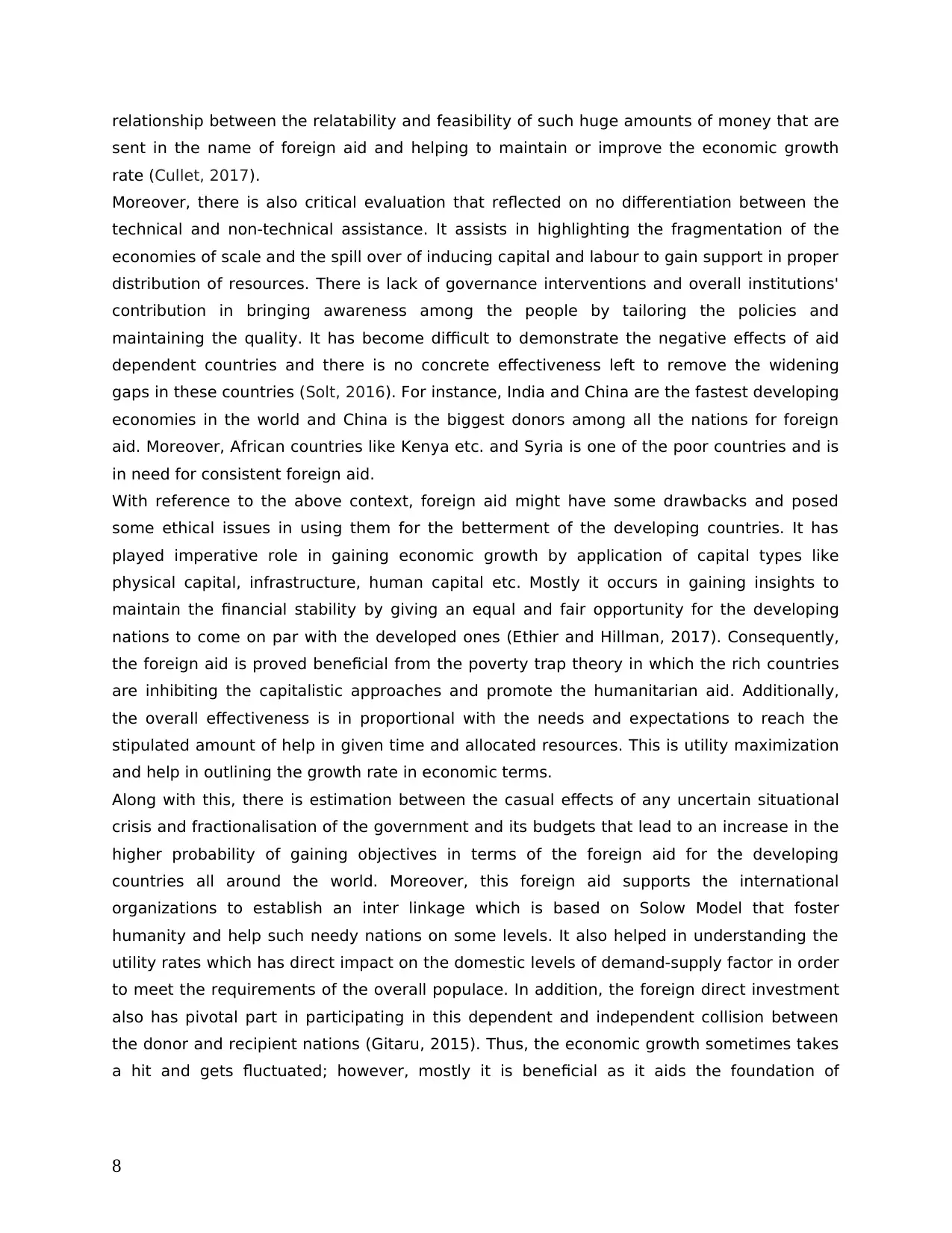
relationship between the relatability and feasibility of such huge amounts of money that are
sent in the name of foreign aid and helping to maintain or improve the economic growth
rate (Cullet, 2017).
Moreover, there is also critical evaluation that reflected on no differentiation between the
technical and non-technical assistance. It assists in highlighting the fragmentation of the
economies of scale and the spill over of inducing capital and labour to gain support in proper
distribution of resources. There is lack of governance interventions and overall institutions'
contribution in bringing awareness among the people by tailoring the policies and
maintaining the quality. It has become difficult to demonstrate the negative effects of aid
dependent countries and there is no concrete effectiveness left to remove the widening
gaps in these countries (Solt, 2016). For instance, India and China are the fastest developing
economies in the world and China is the biggest donors among all the nations for foreign
aid. Moreover, African countries like Kenya etc. and Syria is one of the poor countries and is
in need for consistent foreign aid.
With reference to the above context, foreign aid might have some drawbacks and posed
some ethical issues in using them for the betterment of the developing countries. It has
played imperative role in gaining economic growth by application of capital types like
physical capital, infrastructure, human capital etc. Mostly it occurs in gaining insights to
maintain the financial stability by giving an equal and fair opportunity for the developing
nations to come on par with the developed ones (Ethier and Hillman, 2017). Consequently,
the foreign aid is proved beneficial from the poverty trap theory in which the rich countries
are inhibiting the capitalistic approaches and promote the humanitarian aid. Additionally,
the overall effectiveness is in proportional with the needs and expectations to reach the
stipulated amount of help in given time and allocated resources. This is utility maximization
and help in outlining the growth rate in economic terms.
Along with this, there is estimation between the casual effects of any uncertain situational
crisis and fractionalisation of the government and its budgets that lead to an increase in the
higher probability of gaining objectives in terms of the foreign aid for the developing
countries all around the world. Moreover, this foreign aid supports the international
organizations to establish an inter linkage which is based on Solow Model that foster
humanity and help such needy nations on some levels. It also helped in understanding the
utility rates which has direct impact on the domestic levels of demand-supply factor in order
to meet the requirements of the overall populace. In addition, the foreign direct investment
also has pivotal part in participating in this dependent and independent collision between
the donor and recipient nations (Gitaru, 2015). Thus, the economic growth sometimes takes
a hit and gets fluctuated; however, mostly it is beneficial as it aids the foundation of
8
sent in the name of foreign aid and helping to maintain or improve the economic growth
rate (Cullet, 2017).
Moreover, there is also critical evaluation that reflected on no differentiation between the
technical and non-technical assistance. It assists in highlighting the fragmentation of the
economies of scale and the spill over of inducing capital and labour to gain support in proper
distribution of resources. There is lack of governance interventions and overall institutions'
contribution in bringing awareness among the people by tailoring the policies and
maintaining the quality. It has become difficult to demonstrate the negative effects of aid
dependent countries and there is no concrete effectiveness left to remove the widening
gaps in these countries (Solt, 2016). For instance, India and China are the fastest developing
economies in the world and China is the biggest donors among all the nations for foreign
aid. Moreover, African countries like Kenya etc. and Syria is one of the poor countries and is
in need for consistent foreign aid.
With reference to the above context, foreign aid might have some drawbacks and posed
some ethical issues in using them for the betterment of the developing countries. It has
played imperative role in gaining economic growth by application of capital types like
physical capital, infrastructure, human capital etc. Mostly it occurs in gaining insights to
maintain the financial stability by giving an equal and fair opportunity for the developing
nations to come on par with the developed ones (Ethier and Hillman, 2017). Consequently,
the foreign aid is proved beneficial from the poverty trap theory in which the rich countries
are inhibiting the capitalistic approaches and promote the humanitarian aid. Additionally,
the overall effectiveness is in proportional with the needs and expectations to reach the
stipulated amount of help in given time and allocated resources. This is utility maximization
and help in outlining the growth rate in economic terms.
Along with this, there is estimation between the casual effects of any uncertain situational
crisis and fractionalisation of the government and its budgets that lead to an increase in the
higher probability of gaining objectives in terms of the foreign aid for the developing
countries all around the world. Moreover, this foreign aid supports the international
organizations to establish an inter linkage which is based on Solow Model that foster
humanity and help such needy nations on some levels. It also helped in understanding the
utility rates which has direct impact on the domestic levels of demand-supply factor in order
to meet the requirements of the overall populace. In addition, the foreign direct investment
also has pivotal part in participating in this dependent and independent collision between
the donor and recipient nations (Gitaru, 2015). Thus, the economic growth sometimes takes
a hit and gets fluctuated; however, mostly it is beneficial as it aids the foundation of
8
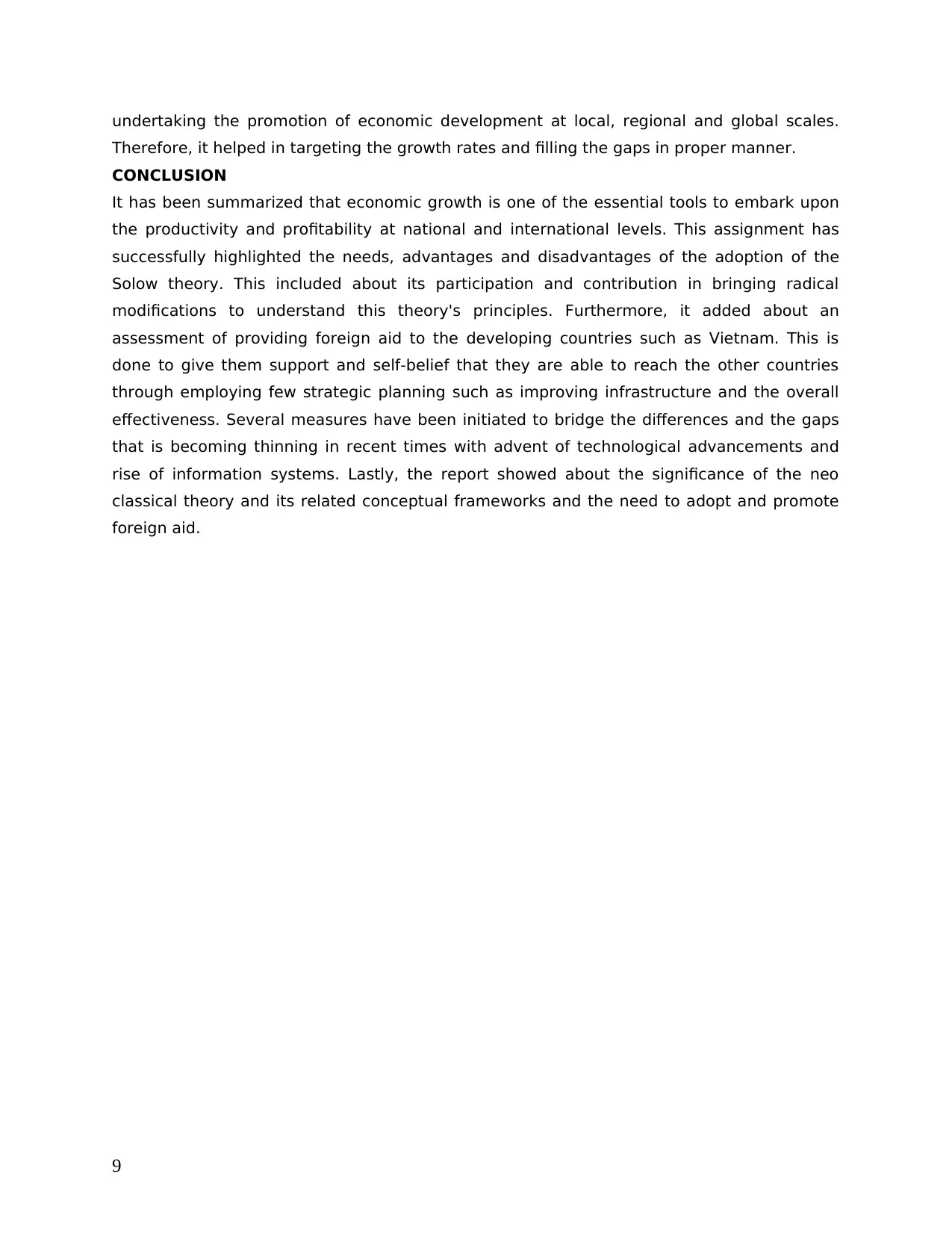
undertaking the promotion of economic development at local, regional and global scales.
Therefore, it helped in targeting the growth rates and filling the gaps in proper manner.
CONCLUSION
It has been summarized that economic growth is one of the essential tools to embark upon
the productivity and profitability at national and international levels. This assignment has
successfully highlighted the needs, advantages and disadvantages of the adoption of the
Solow theory. This included about its participation and contribution in bringing radical
modifications to understand this theory's principles. Furthermore, it added about an
assessment of providing foreign aid to the developing countries such as Vietnam. This is
done to give them support and self-belief that they are able to reach the other countries
through employing few strategic planning such as improving infrastructure and the overall
effectiveness. Several measures have been initiated to bridge the differences and the gaps
that is becoming thinning in recent times with advent of technological advancements and
rise of information systems. Lastly, the report showed about the significance of the neo
classical theory and its related conceptual frameworks and the need to adopt and promote
foreign aid.
9
Therefore, it helped in targeting the growth rates and filling the gaps in proper manner.
CONCLUSION
It has been summarized that economic growth is one of the essential tools to embark upon
the productivity and profitability at national and international levels. This assignment has
successfully highlighted the needs, advantages and disadvantages of the adoption of the
Solow theory. This included about its participation and contribution in bringing radical
modifications to understand this theory's principles. Furthermore, it added about an
assessment of providing foreign aid to the developing countries such as Vietnam. This is
done to give them support and self-belief that they are able to reach the other countries
through employing few strategic planning such as improving infrastructure and the overall
effectiveness. Several measures have been initiated to bridge the differences and the gaps
that is becoming thinning in recent times with advent of technological advancements and
rise of information systems. Lastly, the report showed about the significance of the neo
classical theory and its related conceptual frameworks and the need to adopt and promote
foreign aid.
9
⊘ This is a preview!⊘
Do you want full access?
Subscribe today to unlock all pages.

Trusted by 1+ million students worldwide
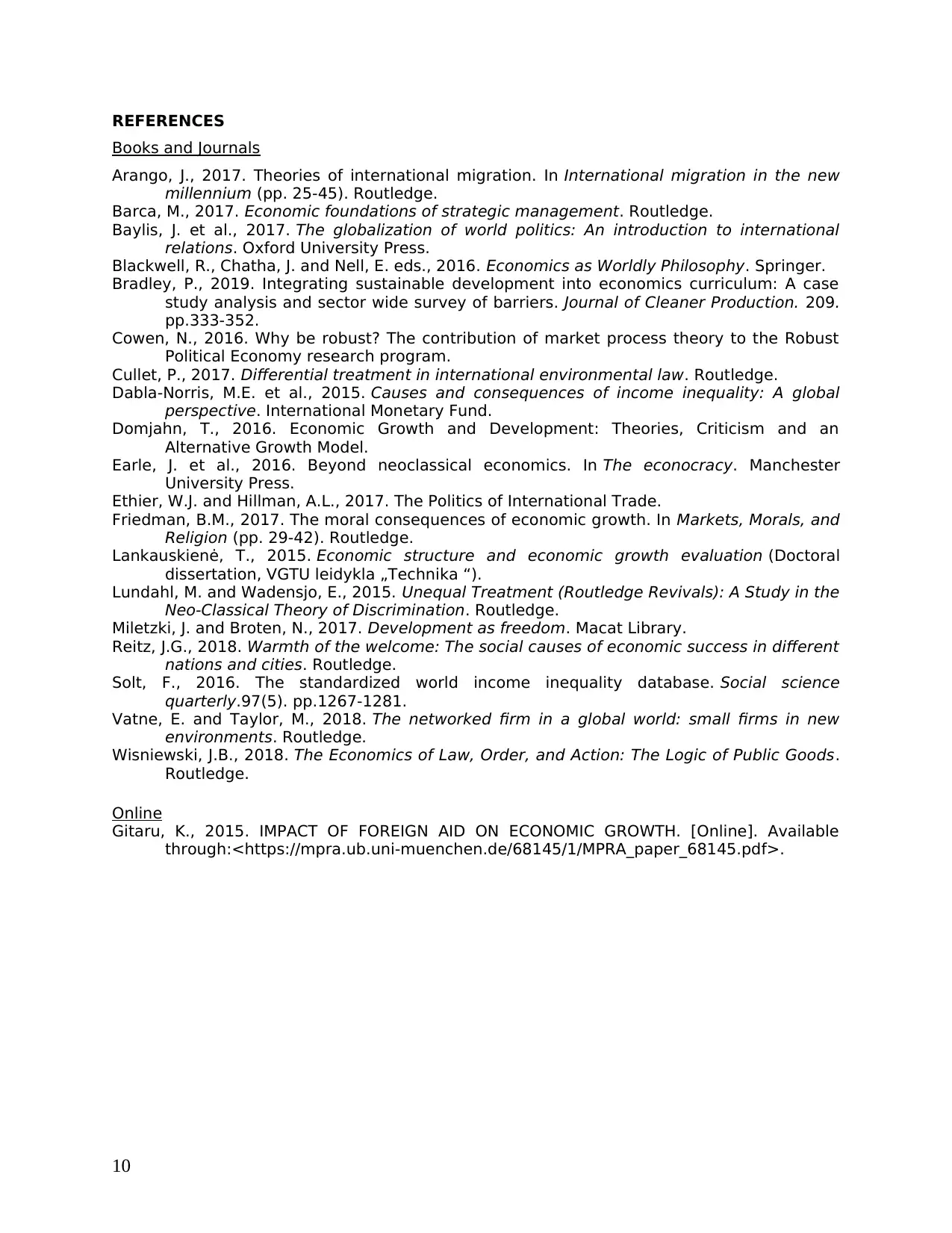
REFERENCES
Books and Journals
Arango, J., 2017. Theories of international migration. In International migration in the new
millennium (pp. 25-45). Routledge.
Barca, M., 2017. Economic foundations of strategic management. Routledge.
Baylis, J. et al., 2017. The globalization of world politics: An introduction to international
relations. Oxford University Press.
Blackwell, R., Chatha, J. and Nell, E. eds., 2016. Economics as Worldly Philosophy. Springer.
Bradley, P., 2019. Integrating sustainable development into economics curriculum: A case
study analysis and sector wide survey of barriers. Journal of Cleaner Production. 209.
pp.333-352.
Cowen, N., 2016. Why be robust? The contribution of market process theory to the Robust
Political Economy research program.
Cullet, P., 2017. Differential treatment in international environmental law. Routledge.
Dabla-Norris, M.E. et al., 2015. Causes and consequences of income inequality: A global
perspective. International Monetary Fund.
Domjahn, T., 2016. Economic Growth and Development: Theories, Criticism and an
Alternative Growth Model.
Earle, J. et al., 2016. Beyond neoclassical economics. In The econocracy. Manchester
University Press.
Ethier, W.J. and Hillman, A.L., 2017. The Politics of International Trade.
Friedman, B.M., 2017. The moral consequences of economic growth. In Markets, Morals, and
Religion (pp. 29-42). Routledge.
Lankauskienė, T., 2015. Economic structure and economic growth evaluation (Doctoral
dissertation, VGTU leidykla „Technika “).
Lundahl, M. and Wadensjo, E., 2015. Unequal Treatment (Routledge Revivals): A Study in the
Neo-Classical Theory of Discrimination. Routledge.
Miletzki, J. and Broten, N., 2017. Development as freedom. Macat Library.
Reitz, J.G., 2018. Warmth of the welcome: The social causes of economic success in different
nations and cities. Routledge.
Solt, F., 2016. The standardized world income inequality database. Social science
quarterly.97(5). pp.1267-1281.
Vatne, E. and Taylor, M., 2018. The networked firm in a global world: small firms in new
environments. Routledge.
Wisniewski, J.B., 2018. The Economics of Law, Order, and Action: The Logic of Public Goods.
Routledge.
Online
Gitaru, K., 2015. IMPACT OF FOREIGN AID ON ECONOMIC GROWTH. [Online]. Available
through:<https://mpra.ub.uni-muenchen.de/68145/1/MPRA_paper_68145.pdf>.
10
Books and Journals
Arango, J., 2017. Theories of international migration. In International migration in the new
millennium (pp. 25-45). Routledge.
Barca, M., 2017. Economic foundations of strategic management. Routledge.
Baylis, J. et al., 2017. The globalization of world politics: An introduction to international
relations. Oxford University Press.
Blackwell, R., Chatha, J. and Nell, E. eds., 2016. Economics as Worldly Philosophy. Springer.
Bradley, P., 2019. Integrating sustainable development into economics curriculum: A case
study analysis and sector wide survey of barriers. Journal of Cleaner Production. 209.
pp.333-352.
Cowen, N., 2016. Why be robust? The contribution of market process theory to the Robust
Political Economy research program.
Cullet, P., 2017. Differential treatment in international environmental law. Routledge.
Dabla-Norris, M.E. et al., 2015. Causes and consequences of income inequality: A global
perspective. International Monetary Fund.
Domjahn, T., 2016. Economic Growth and Development: Theories, Criticism and an
Alternative Growth Model.
Earle, J. et al., 2016. Beyond neoclassical economics. In The econocracy. Manchester
University Press.
Ethier, W.J. and Hillman, A.L., 2017. The Politics of International Trade.
Friedman, B.M., 2017. The moral consequences of economic growth. In Markets, Morals, and
Religion (pp. 29-42). Routledge.
Lankauskienė, T., 2015. Economic structure and economic growth evaluation (Doctoral
dissertation, VGTU leidykla „Technika “).
Lundahl, M. and Wadensjo, E., 2015. Unequal Treatment (Routledge Revivals): A Study in the
Neo-Classical Theory of Discrimination. Routledge.
Miletzki, J. and Broten, N., 2017. Development as freedom. Macat Library.
Reitz, J.G., 2018. Warmth of the welcome: The social causes of economic success in different
nations and cities. Routledge.
Solt, F., 2016. The standardized world income inequality database. Social science
quarterly.97(5). pp.1267-1281.
Vatne, E. and Taylor, M., 2018. The networked firm in a global world: small firms in new
environments. Routledge.
Wisniewski, J.B., 2018. The Economics of Law, Order, and Action: The Logic of Public Goods.
Routledge.
Online
Gitaru, K., 2015. IMPACT OF FOREIGN AID ON ECONOMIC GROWTH. [Online]. Available
through:<https://mpra.ub.uni-muenchen.de/68145/1/MPRA_paper_68145.pdf>.
10
1 out of 10
Related Documents
Your All-in-One AI-Powered Toolkit for Academic Success.
+13062052269
info@desklib.com
Available 24*7 on WhatsApp / Email
![[object Object]](/_next/static/media/star-bottom.7253800d.svg)
Unlock your academic potential
Copyright © 2020–2025 A2Z Services. All Rights Reserved. Developed and managed by ZUCOL.





